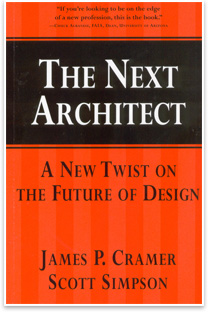REVIEW
Futurism with a Twist
From The Next Architect: A New Twist on the Future of Design, by James P. Cramer, Hon. AIA, and Scott Simpson, FAIA (Greenway Communications/Ostberg, 2007).
Summary: In
the second edition of their book The
Next Architect, (the first edition
sold out this summer in six weeks), former AIA CEO/current Greenway
Group Chair and CEO Jim Cramer, Hon. AIA, and former AIA director/current
president and CEO of The Stubbins Associates Scott Simpson, FAIA,
tell us that the design and construction industry is teetering
on the tipping point of great change. “Some of these [changes]
are driven by new technologies and improved process, and others by
a basic shift in attitude. Design itself is being redesigned,” they
write. “The more we thought about this, the more intrigued
we became, and that’s how The
Next Architect was born.”
 The Next Architect will intrigue the architect-reader, too, on this easy-to-read journey through a series of essays—in chapter-size chunks—that range from “your inner architect” to “process innovation” to “dynamic decision-making” to (the best!) “fun with money.” It presents the fascinating concept of money as a design tool, to be used like any other in the architect’s repertoire to create value for the client. The Next Architect will intrigue the architect-reader, too, on this easy-to-read journey through a series of essays—in chapter-size chunks—that range from “your inner architect” to “process innovation” to “dynamic decision-making” to (the best!) “fun with money.” It presents the fascinating concept of money as a design tool, to be used like any other in the architect’s repertoire to create value for the client.
Framework for meeting demands of new trends
Cramer and Stubbins have created a framework through which to ponder 14 trends driving the profession:
- Integrated, collaborative design: “Owners, architects, engineers, consultants, and contractors will operate using a single technology platform that will enable and require all disciplines to work simultaneously and interactively,” the authors predict
- Design-build dominates: As the process of designing and building becomes more streamlined, owners are looking for a single entity to provide integrated services
- Globalization comes home: Traditional international borders are factoring less and less into the design process as all firms potentially now can practice globally and global firms now can practice locally
- Talent shortage: With fewer younger staffers following the baby boomers and other professional careers offering higher salaries, firms are looking to innovative ways to get and keep talented employees
- BIM technology sets a new standard: BIM is transforming design product from paper to an integrated database
- Demographics is destiny: Baby boomers, the last generation born before the Digital Revolution, are having a huge effect on demographic trends as they approach retirement age and move from suburb to city, look to continuing-care retirement communities, and spend more money on travel and entertainment
- Productivity and performance: The digital revolution—3D and 4D CAD—are allowing architects to spend more time thinking and less time drawing
- The power of branding: You have a brand (your culture made manifest), whether you like it or not: “Strategic branding is the best antidote to the commoditization in the design professions,” the authors tell us
- Fast architecture: Using new technologies
and management techniques, architects are discovering that speed
is “not necessarily the enemy of quality”; and clients
are demanding speed
- Designing the “design experience”: Clients are increasingly aware that the experience of using a building or space is increasingly important to their clients and users
- Going green: Architects are uniquely positioned to work with politicians, business leaders, and the academy to advance the role of sustainable design
- Life-cycle design: New services and income streams for architects will evolve as clients recognize that there is no one better to help care for a building than the people who designed it in the first place
- High definition value: Architects are creating design value, not selling lines on paper, and therefore need to work on an expanded vocabulary to explain what they deliver
- Strategic optimism: Clients respond to that “can do” attitude, especially in a profession that always “has more answers than questions.”
Cramer and Simpson believe that the stars are aligning to create
a new position of leadership, and that the new leader will be “the
next architect: the person (or firm) truly energized by what’s
ahead and willing to provide the energy, focus, commitment, and inspiration
to make it happen.”
—SS
|


 The Next Architect
The Next Architect